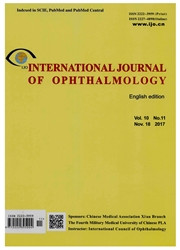

 中文摘要:
中文摘要:
AIM: To investigate the effect of nitric oxide and its synthetase on experimental corneal neovascularization (CRNV). METHODS: CRNV was induced by alkali injury in mice, nitric oxide synthetase (NOS) was inhibited by NG-nitro-L-arginine (L-NAME) and inducible nitric oxide synthetase (iNOS) was inhibited by aminoguanidine hemisulfate salt (AG). The inhibitory effect was detected at day 2 and 4 after corneal alkali injury by reverse transcription polymerase chain reaction (RT-PCR). CRNV was compared between the control and the treated mice by microscopic observation and corneal whole mount CD31 immunostaining. RESULTS: The inhibition of L-NAME to NOS and AG to iNOS after corneal injury was confirmed by RT-PCR (P 【0.05). Compared with control mice, L-NAME treated mice exhibited significantly decreased CRNV areas (P 【0.05). In contrast, AG treatment failed to attenuate alkali induced CRNV (P 】0.05). CONCLUSION: Our findings suggest that NOS but not iNOS plays a critical role in alkali injury induced CRNV.
 英文摘要:
英文摘要:
AIM: To investigate the effect of nitric oxide and its synthetase on experimental corneal neovascularization (CRNV). METHODS: CRNV was induced by alkali injury in mice, nitric oxide synthetase (NOS) was inhibited by NG-nitro-L-arginine (L-NAME) and inducible nitric oxide synthetase (iNOS) was inhibited by aminoguanidine hemisulfate salt (AG). The inhibitory effect was detected at day 2 and 4 after corneal alkali injury by reverse transcription polymerase chain reaction (RT-PCR). CRNV was compared between the control and the treated mice by microscopic observation and corneal whole mount CD31 immunostaining. RESULTS: The inhibition of L-NAME to NOS and AG to iNOS after corneal injury was confirmed by RT-PCR (P <0.05). Compared with control mice, L-NAME treated mice exhibited significantly decreased CRNV areas (P<0.05). In contrast, AG treatment failed to attenuate alkali induced CRNV (P>0.05). CONCLUSION: Our findings suggest that NOS but not iNOS plays a critical role in alkali injury induced CRNV.
 同期刊论文项目
同期刊论文项目
 同项目期刊论文
同项目期刊论文
 Potential involvement of nitric oxide synthase but not inducible nitric oxide synthase in the develo
Potential involvement of nitric oxide synthase but not inducible nitric oxide synthase in the develo Critical role of SDF-1 alpha-induced progenitor cell recruitment and macrophage VEGF production in t
Critical role of SDF-1 alpha-induced progenitor cell recruitment and macrophage VEGF production in t 期刊信息
期刊信息
